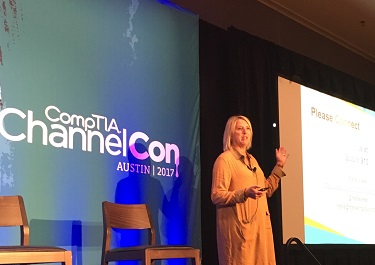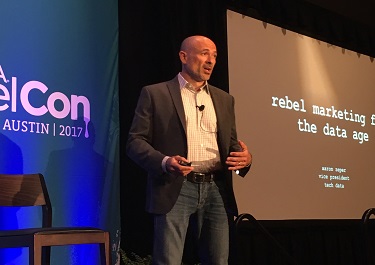 Business has lost that personal touch today ‒ and consumers are perfectly fine with it. In fact, they're usually the ones driving that change with online purchasing and mobile apps that simplify and speed up the buying process. Many have leaped the digital divide and are perfectly content having little or no personal contact with sellers.
Business has lost that personal touch today ‒ and consumers are perfectly fine with it. In fact, they're usually the ones driving that change with online purchasing and mobile apps that simplify and speed up the buying process. Many have leaped the digital divide and are perfectly content having little or no personal contact with sellers.
And they aren't just buying socks on Amazon. Marie Wiese, founder and president of Marketing CoPilot, a Toronto-based digital marketing strategy firm, walked the ChannelCon audience through her journey buying a Volkswagen camper. Memories from her youth created the inspiration, so she decided to use social media and online search to locate and hopefully purchase her own classic model. Not only did Wiese accomplish her mission, but she never talked to a human until picking up the vehicle.
You can buy anything online that way today. While it's fantastic for consumers, there are scores of small businesses that continue to use traditional promotions and sales techniques. As Weise emphasized at ChannelCon, "the old marketing channels don't work the way they used to. The research shows that 70% of people want to find out about new products and services through email today, while 11% prefer social media and only a little more than 1% of them do it through traditional phone calls."
Like it or not, the best sales resource a company has is its website ‒ including IT services companies. It's a 24/7, 365 day a year business enabler, and many channel companies leverage them properly. "We need to do a better job making websites a valuable tool for the sales team," adds Wiese. "Buyers now get 70% of the way through the buying process before they speak to a person, so their online experience has to be good."
She emphasizes that the buying process has changed, and therefore the sales funnel has changed. IT firms need to do a better job defining and targeting their ideal clients. In the digital age, that presents several challenges, including "building trust when you can't look people in the eye." Small businesses often struggle with online strategies, not knowing which media to use, where to invest limited dollars, and how to create the best content.
The first step, according to Wiese, is to "understand who your ideal customers are and how they find solutions like yours. Then articulate why they should buy from you." That means developing value-added content such as case studies and targeted messages that connect with their business needs, giving them real reasons to buy. "Whatever you do, be sure to structure your marketing efforts to support the ideal customer," she stressed. "The price of entry is getting it right."
Rebel with a Cause
 "Everything you do that interacts with a client or prospect, as well as what they see, feel or experience with your company, is marketing," says Aaron Zeper, Vice President of STG Tech Data. Promotion is everywhere, from a news story (good or bad) and social media to outbound calling and customer service interactions. Prospects and clients are more tuned in that ever to what businesses are doing.
"Everything you do that interacts with a client or prospect, as well as what they see, feel or experience with your company, is marketing," says Aaron Zeper, Vice President of STG Tech Data. Promotion is everywhere, from a news story (good or bad) and social media to outbound calling and customer service interactions. Prospects and clients are more tuned in that ever to what businesses are doing.
Two major obstacles for small businesses are complacency and lack of customer insight. In other words, "if you believe you own your message, you're mistaken," suggests Zeper. Many companies fall into a trap, believing they know more about their customers than they actually do ‒ and their outbound communications often reflect it. Some groups respond better to long emails if the message hits its intended target, while others prefer shorter communications with a few simple highlights.
The key is being willing to explore. Do you know what it takes to capture the attention of your prospective and current customers? Zeper suggests that IT firms shake things up a bit to grow their sales in today's cluttered, digitally enhanced marketing environment.
For example, Zeper replaced an outsource email campaign that had netted no returns with more personalized messages from real employees. The company landed two large contracts by making that modest change.
It doesn't have to be complicated. Other ideas include simplifying the design of quotes, minimizing the text and use of complicated terms for non-technical decision makers. Add links to additional details, or reference where to find supporting information. Make all messages easily consumable for your customers.
Take the same approach with promotions. "Reduce the words used in outbound marketing materials, and add a little good-natured humor whenever possible. The important thing is to quantify the cost of acquiring leads and use that as the baseline for whatever campaigns you create," adds Zeper.

 Add CompTIA to your favorite RSS reader
Add CompTIA to your favorite RSS reader

